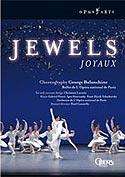|
Back
12/03/2011
George Balanchine: Jewels (music by Gabriel Fauré, Igor Stravinsky, and Pyotr Ilyich Tchaikovsky)
The Ballet national de l’Opéra de Paris: Aurélie Dupont, Marie-Agnès Gillot, Agnès Letestu, Clairemarie Osta, Laëtitia Pujol, Jean-Guillaume Bart, Kader Belarbi, Mathieu Ganio (Étoile Dancers), Eleonora Abbaniato, Nolwenn Daniel, Emmanuel Thibault, Isabelle Ciaravola, Émilie Cozette (First Dancers), and corps de ballet, Jean-Yves Sébillotte (piano), The Orchestre national de l’Opéra de Paris, Paul Connelly (Conductor), George Balanchine (Choreography), Christian Lacroix (Set and costume Designer), Jennifer Tipton (Lighting Designer), Pierre Cavassilas (TV Director)
Recorded live at the Opéra de Paris, Palais Garnier (October/November 2005) – 152’
OPUS ARTE ref. #: 0951D – Picture format: 16:9 – Audio format: LPCM Stereo/Digital dts – Liner notes in English, French, & German

To date, this is the only commercially available DVD of Balanchine’s three-act masterpiece, Jewels. Besides the Paris Opera Ballet, only top-notch companies perform it with some regularity: the New York City Ballet (where it premiered in 1967), the Mariinsky Ballet, the Miami City Ballet, the San Francisco Ballet, and the Royal Ballet, Covent Garden.
This abstract, storyless tryptic consists of Emeralds, set to music by Fauré (Pelléas et Mélisande and Shylock), Rubies set to Stravinsky’s Capriccio, and Diamonds to Tchaikovsky’s Third Symphony in D major. The three parts stylistically contrast with each other but have a common thread, a prevalent aura of elegance and luxury.
In Emeralds, an homage to French dance, Laëtitia Pujol, Mathieu Ganio, Clairemarie Osta, and Kader Belarbi dance with remarkable softness and flawless technique. Pujol is fluid in attacks, sensual and dreamy, while Belarbi and Ganio, impeccable and always musical, offer clear evidence of Balanchine’s ideal to “see the music and hear the dancing.”
Rubies, Balanchine’s tribute to his adopted home of America, is set to a perky, blustering score by Stravinsky. The quicksilver choreography turns classical positions into acrobatics. It is filled with strong, hard kicks, striking fast arabesque penchées, and a lot of off-centered hip swaggering. Aurélie Dupont nails all the steps, including some amazingly clean triple and quadruple pirouettes, but may not have the required carefree sass and cheekiness that is so typical of American music theater. Agnès Gillot is delightful in the hip-strutting, sensual personality of her part and injects every moment with a personal stamp.
Diamonds evokes the classical legacy of choreographers Marius Petitpa and Lev Ivanov. It is a festive and glamorous way to end the performance. Agnès Letestu and Jean-Guillaume Bart, both tall and stately dancers with a natural dignity and clarity of movement, are admirable in the lead roles. The final ensemble of Diamonds, with a large corps de ballet swamping the stage in a sea of scintillating tutus, truly captures the grandeur of a Petipa ballet.
The Paris Opera Ballet, rightly considered as the cradle of classical dance, offers yet another stunning performance, confirming, if need be, its role as one of the top ranking ballet companies.
Haute couture designer Christian Lacroix pens stylish costumes, luckily not overwhelming, and minimalist sets that evoke the glitter of the gems and the brilliance of the choreography. Paul Connelly, at the helm of the Orchestre national de l’Opéra de Paris, and pianist Jean-Yves Sébillotte add a string of pearls to an impressive performance.
This DVD also includes an interesting documentary, George Balanchine Forever, by Reiner E. Moritz, with interviews of Étoile dancers, company director Brigitte Lefèvre, and longtime Balanchine assistant Barbara Hogan. Those unfamiliar with Balanchine may want to view this documentary prior to the ballet as it provides valuable insight on his choreography.
A DVD to treasure.
Christian Dalzon
|